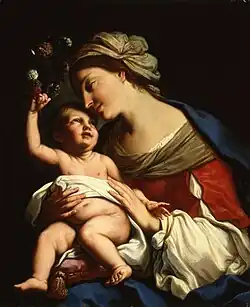Elisabetta Sirani
Elisabetta Sirani (8 January 1638 – 28 August 1665) was an Italian Baroque painter and printmaker who died in unexplained circumstances at the age of 27.[1] She was one of the first women artists in early modern Bologna, who established an academy for other women artists.[2]
Elisabetta Sirani | |
|---|---|
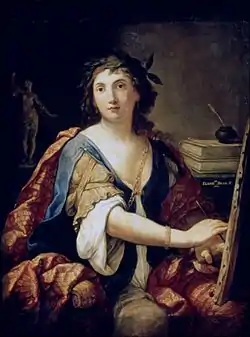 Self-Portrait as Allegory of Painting (1658) by Elisabetta Sirani, Pushkin Museum, Moscow | |
| Born | 8 January 1638 |
| Died | 28 August 1665 (aged 27) Bologna, Holy Roman Empire |
| Nationality | Italian |
| Education | Family |
| Known for | Painting |
| Movement | Baroque |
Life
Elisabetta Sirani was born in Bologna on 8 January 1638, the first of four children of Margherita and Giovanni Andrea Sirani. Giovanni was an art merchant and painter of the School of Bologna, having been a favorite pupil of Guido Reni. He did not produce many works during his lifetime; instead, he took over Reni's job as a teacher, and became the master in the first life school held in the house of Ettore Ghislieri.
Sirani first trained as a painter in her father's studio.[3] There is evidence that Giovanni was not inclined at first to have his daughter as a pupil, but she picked up his technique nonetheless and became one of the most renowned painters in Bologna. The art biographer Carlo Cesare Malvasia, a personal acquaintance of the Sirani family, claimed credit for recognizing Elisabetta's talent and persuading her father to train her as a painter, although this was likely self-aggrandizing.[4]
Sirani's biography is included in Malvasia's two-volume Felsina pittrice: vite de’pittori bolognesi, or Lives of the Bolognese Painters, first published in 1678.[5] She is presented therein as the epitome of Bolognese genius, and Malvasia takes much pride in his (alleged) contribution to her early career.[6] Throughout, he praises the originality of her compositions, her style of drawing, her fast manner of working and her professionalism, contrasting her with Lavinia Fontana, an earlier Bolognese woman painter whom he describes as timid.[7]
In establishing her painting style, Sirani studied the works of Annibale Carracci, Lorenzo Pasinelli, Desubleo, Simone Cantarini, and Cignani. Along with technique, her early education included outlines of Bible history and the legends of saints, as well as Classical mythology. Sirani received her first commission in her teens, a Baptism of Christ, which was a companion piece to an earlier done painting by her father at the Campo Santo of Bologna. She was also knowledgeable in music, one of the reasons being that her brother-in-law was a musician.
According to some scholars, Sirani's artistic reputation soon overshadowed that of both her father and her two sisters, who were also painters. By 1654, Giovanni Andrea Sirani became incapacitated by gout, so Elisabetta began running her family's workshop.[8] At this point, she was the household's primary breadwinner, supporting the family with her teaching fees and portrait commissions. Her studio was highly successful, partially due to the progressive atmosphere of Bologna, where women artists were accepted and celebrated.[9]
Death
Sirani died suddenly in August 1665, in Bologna. Her death was considered suspicious and a maidservant, Lucia Tolomelli, was charged with poisoning the artist and put on trial. Suspicion fell on Tolomelli because she had requested to end her service to the family only days before Sirani's death. Giovanni Andrea Sirani withdrew the charges soon after the trial.[10] Laura Ragg comments that Sirani died at "an age regarded as young indeed for death, but hopelessly late for marriage." Malvasia attributed her death to love-sickness because Sirani never married.[11] Her actual cause of death was most likely the onset of peritonitis after a ruptured peptic ulcer.[12] This may have been the result of the intense stress she was submitted to after she was charged with providing for her entire household.
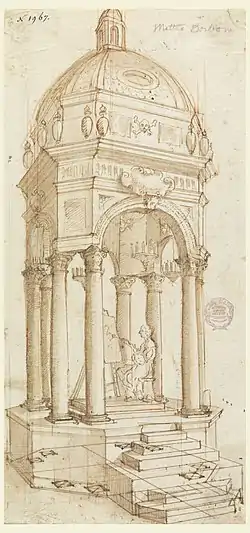
Sirani was given an elaborate funeral which included an enormous catafalque with a life-sized sculpture of the artist (illustrated in Malvasia's biography), orations and music composed in her honor by Bologna's most prominent citizens, and she was buried in the Basilica of San Domenico, Bologna, in the same tomb as her father's teacher, Guido Reni.[13] Sirani's public funeral is regarded by some, including Laura Ragg, as a eulogy to Bologna, the city that gave birth to Sirani, considered a precocious and prolific artist by her contemporaries. Sirani was described by a poet as the Lamented Paintbrush. Malvasia suggests that it was not poisoning but a condition that arose spontaneously in the body of a “vivacious and spirited woman, concealing to the highest degree her craving for a perhaps coveted husband denied to her by her father.” A city official at the time wrote that “She is mourned by all. The ladies especially whose portraits she flattered, cannot hold their peace about it. Indeed it is a great misfortune to lose such great artist in so strange a manner.” The ostentatious and elaborate funeral she received reflects the high esteem she was held in by her contemporaries and indeed her international fame.[14]
Pupils
Not only was Elisabetta Sirani the successor of her father's workshop, she was also a great teacher of many, especially contributing to women artists’ development during the Renaissance period. She trained a number of men and women artists, including her younger sisters Barbara and Anna Maria and at least twelve other young women at the school she set up.[15] This became the first school of painting for women in Europe outside of a convent, and it was inclusive regardless of the women's artistic and social connections.[16]
Some of her pupils included Veronica Fontana, later known throughout Italy as a first-rate wood-engraver; Caterina Pepoli and Maria Elena Panzacchi, who also had art careers in Bologna; Camelia Lanteri and Lucretia Forni, who specialized in large-scale religious paintings; and Veronica Franchi, whose predilection was for mythological subjects. Lucrezia Scarfaglia was another pupil.[17] Lastly, there was Ginevra Cantofoli, represented during her career as Sirani's enemy and rival.[18]
Works
Sirani produced over 200 paintings, 15 etchings, and hundreds of drawings, making her an extremely prolific artist, especially considering her early death.[19] Of these hundreds of drawings, about a quarter relate to known paints or prints done by Sirani.[20] Sirani kept a meticulous list and records of her paintings and who commissioned them beginning in 1655, which is recorded in Malvasia's biography. Additionally many of her paintings are signed,[14] which was not a common practice among her male counterparts. It's possible that she chose to do this in order to avoid her work being confused with that of her father. Her signature also offered a way to further prove her powers of invention, which, according to Ann Sutherland Harris, distinguished her from other Italian women artists.[21] Sirani's exceptional prodigiousness was the product of how quickly she painted. She painted so many works that many doubted that she painted them all herself. To refute such charges she invited her accusers on 13 May 1664 to watch her paint a portrait in one sitting.[22]
Her works cover a number of subjects, including historical and Biblical narratives, allegories, and portraits, all of which often featured women. Sirani was the first female artist in Bologna to specialize in history painting, and many of the women painters that Sirani trained followed suit.[20] Sirani's specialization in history painting is very different than other female painters of the time, who usually only painted still lifes. She received her first major public commission in 1657 in Bologna, from Daniele Granchi, prior of the Carthusian church of Certosa di Bologna.[20]
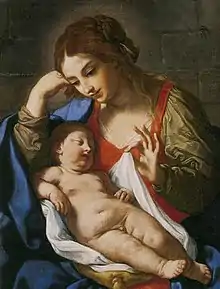
She painted at least 13 public altarpieces, including The Baptism of Christ at the Certosa di Bologna of 1658.[23] Around 1660, she began focusing extensively on small-scale devotional images, particularly the Virgin and Child and Holy Family, which were enormously popular with private collectors.[24] Her patrons ranged from cardinals to kings, princes, dukes, merchants, and academics from Bologna and across Europe.[25] Sirani became a celebrity in her city as visitors, such as diplomats, political leaders, and noblemen, would come to her studio to watch her work.[26]
Sirani's style is close to that of her father's teacher, Guido Reni, but Sirani employed more dramatic contrasts of light and shade, virtuoso brushstrokes, and more brilliant color.[27] More similarities of her works may be found in the draftsmanship of Ludovico Carracci, Giovanni Francesco Barbieri (Guercino), and Simone Cantarini (Bohn). Her striking images of female heroines, such as Portia Wounding Her Thigh are comparable to the work of Artemisia Gentileschi. Sirani often selected lesser-known subjects for her paintings and her unique interpretation of iconography drew praise from a number of contemporaries.[23] “Sirani made drawings in a variety of media, such as brush and wash, pen and ink with wash, black chalk, red chalk, and a combination of the two.”[20] Her drawings, while done in many different media, usually in pen or brush and ink, display the same brilliance as her paintings, often quickly executed with what Malvasia describes as "nonchalance."[28]
Sirani managed to thwart visual gender conventions, whereby portraiture was the expected genre for female artists. Instead, she transformed the format into an allegorical mode that solicits the observer's interpretation of the work. Sirani based many of her allegories on Cesare Ripa's descriptions from his Iconologia, published in 1611. Some of her favored topics included Greek and Roman mythology, mythological figures, and the poetry of Horace.[29]
Male nudity was not often attempted by female artists of the time as they did not wish to display their lack of experience from life-drawing (a practice which was typically withheld from them). They were aware of the prurient effect that the inclusion of such subject matter may have on their reputations. If the male nude was depicted it was usually done in a religious context, for example many depictions of Jesus Christ.[30] Another example is the composition of Ten Thousand Crucified Martyrs', which is replete with male nude figures. While it does fall under this religious category of the male nude, Sirani's work displays a strong sense of individuality.
Judith and Holofernes, c. 1660s

The subject of Judith is a popular one for female artists of the seventeenth century, and even before and after. The number of women completing and studying history paintings increased at this time. This was especially prevalent for those who had fathers who exclusively studied history painting, or mostly this topic. Elisabetta Sirani was no exception, as her father studied and taught history painting. In Sirani's rendition, Judith is the apex figure, creating a classical, triangular composition reminiscent of the Renaissance. Judith's handmaiden is old and decrepit, aiding Judith with carrying the head of Holofernes. Sirani portrays Judith in the nighttime, succumbing to the viewer with her act of murder. This painting has been compared to Gentileschi's Judith Slaying Holofernes from 1620, which has often been regarded as violent. Both represent Judith as a strong figure, though Sirani's hierarchically reaches the top of the picture plane. Whereas Gentileschi portrays the handmaiden in total collusion with Judith, Sirani depicts a less active handmaiden, emphasizing the forcefulness of Judith in this way.
In other renditions of Judith and Holofernes by Sirani, Judith is still cool and mild-mannered. Her fierceness lies in the action of slaying Holofernes, rather than in her face or movements within the composition. In each of Sirani's versions, Judith does not look at the severed head of Holofernes. Rather than being decisive and involved, as Gentileschi's Judiths are, she is rather a beautiful woman to be regarded and appraised. This fact and comparison to Gentileschi proves that the underlying female-ness of the paintings have nothing in common other than the fact that they were both created by women. Feminist art historians have observed this as an example of how women artists stand on their own and distinguish themselves from each other.
St. Anthony of Padua, 1662

This painting is hung in the Pinacoteca in Bologna near the work of Guido Reni. The young saint, who is normally portrayed as an ascetic dreamer, is seen here kneeling as a lover of children. The celestial children are painted with an essence of earthly delight that some scholars regard as never been done before. The composition reveals a diagonal thrust that contrasts greatly with the other paintings in the same gallery. It was commissioned by Giovanni Battista Cremonese, a jeweler.
Portia Wounding Her Thigh, 1664

This painting is often understood from a feminine perspective. The image consists of a somber background and a large Portia clad in red wielding a knife above her already bleeding, exposed thigh. Many feminist scholars regard this as an image of a strong-willed woman. According to Plutarch, the original teller of the story of Portia wounding her thigh, Portia harmed herself greatly to prove to her husband, Brutus, that she could share in his burdens and secrets. The idea was to convince her husband of her strength of will. However, modern scholars reflect how this image may not be as feminist in its message as others have interpreted. Modern scholars argue that the necessity of self-mutilation to prove a woman's strength of will in order to have access to her husband's thoughts questions such a feminist reading. Furthermore, a sadomasochistic sexuality is latent in Portia's exposed thigh, loosened robe, poised knife, and her snake-like headdress. The seventeenth century was rife with dark, sexual, violent, and disturbing images, so it is not surprising that Sirani chose a heavy, closed atmosphere with somber lighting and rich colours. This mode of representation reflects her teacher, Guido Reni, as opposed to Artemisia Gentileschi, whose work is often held up against Sirani's. In this painting, Sirani confirms Reni's overarching sexual ideology, while Gentileschi's work often disrupted this.
In popular culture
Sirani is referenced in Judy Chicago's The Dinner Party[31]
In 1994, a crater on the planet Venus was named after Sirani.[32]
Sirani's painting Virgin and Child of 1663, now in the collection of the National Museum of Women in the Arts in Washington, D.C., was selected for the United States Postal Service Christmas Holiday Stamp series in October 1994.[33] This was the first work by a woman artist chosen for the series.
Her Herodias with the Head of John the Baptist is featured on the cover of the Canadian technical death metal band Cryptopsy's 1996 album None So Vile.
Gallery
 Allegory of Music, 1659
Allegory of Music, 1659 Judith with the Head of Holofernes
Judith with the Head of Holofernes Virgin and Child, ink and wash on paper
Virgin and Child, ink and wash on paper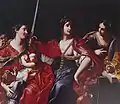 Allegory of Justice, Charity, and Prudence, 1664
Allegory of Justice, Charity, and Prudence, 1664 St. Joseph with the Infant Jesus, c. 1662
St. Joseph with the Infant Jesus, c. 1662 Baptism of Christ, 1658
Baptism of Christ, 1658 Finding of Moses, by 1665
Finding of Moses, by 1665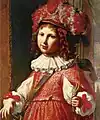 Portrait of Vincenzo Ferdinando Ranuzzi as Amor, 1663
Portrait of Vincenzo Ferdinando Ranuzzi as Amor, 1663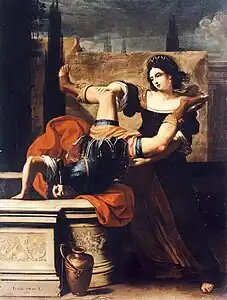 Timoclea Kills the Captain of Alexander the Great, 1659
Timoclea Kills the Captain of Alexander the Great, 1659
References and sources
References
- Malvasia 1678, Vol II, 453–467.
- Modesti, 1–2.
- Marter, Joan; Barlow, Margaret (1 January 2012). "Parallel Perspectives". Woman's Art Journal. 33 (2): 2. JSTOR 24395282.
- Dabbs, 121.
- An English translation of the 1841 edition is provided in Dabbs, 121-32.
- Barker, Sheila (2016). "Elisabetta Sirani 'Virtuosa': Women's Cultural Production in Early Modern Bologna". Renaissance Quarterly. 69 (2): 658–659. doi:10.1086/687630. S2CID 163608026.
- Malvasia 1678, Vol II, 453 and Dabbs 122.
- Modesti, 1.
- Artist Profile: Elisabetta Sirani.
- Malvasia 1678, Vol II, 479 and Dabbs, 131.
- Malvasia 1678, Vol II, 479-80 and Dabbs, 123.
- Moedsti, 1.
- Malvasia 1678, Vol II, 463. Malvasia also reproduces a number of the orations throughout his text.
- Malvasia 1678, Vol II, 467-76 and Italian Women Artists, 241.
- Modesti, 67–79.
- Bohn, Babette (2002). The Antique Heroines of Elisabetta Sirani. Renaissance Studies. 16 (1): 59.
- Vera Fortunati Pietrantonio (1998). Lavinia Fontana of Bologna (1552–1614). Catalogo della mostra (Washington, The National museum of women in the arts, 5 febbraio-7 giugno 1998). Mondadori Electa. ISBN 978-88-435-6394-4.
- Ragg, Laura (1907). The Women Artists of Bologna. Methuen & Co.
- Modesti records a number of the paintings, prints, and drawings in her catalogue.
- Bohn, Babette (1 January 2004). "Elisabetta Sirani and Drawing Practices in Early Modern Bologna". Master Drawings. 42 (3): 207–236. JSTOR 1554659.
- Harris, Ann Sutherland (1 January 2010). "Artemisia Gentileschi and Elisabetta Sirani: Rivals or Strangers?". Woman's Art Journal. 31 (1): 3–12. JSTOR 40605234.
- Heller, Nancy (1991). Women Artists: An Illustrated History. Abbeville Press. p. 33.
- Modesti, 5.
- Italian Women Artists, 241.
- Modesti, 4.
- Modesti, 15.
- Italian Women Artists, 241-48.
- Italian Women Artists, 242 and Bohn, 207-36.
- Rocco, Patricia (2006). Performing Female Artistic Identity: Lavinia Fontana, Elisabetta Sirani and the Allegorical Self-Portrait in Sixteenth and Seventeenth-Century Bologna. McGill University.
- Borzello, Frances (2000). A World of Our Own: Women Artists Since the Renaissance. United States: Watson-Guptill. pp. 53, 63, 69, 74. ISBN 978-0-8230-5874-7.
- "The Dinner Party". Brooklyn Museum. Retrieved 8 March 2015.
- "Sirani". Gazetteer of Planetary Nomenclature. International Astronomical Union (IAU) Working Group for Planetary System Nomenclature (WGPSN). Retrieved 8 March 2015.
- "Christmas Holiday Stamps". United States Postal Service: Our History. United States Postal Service. Archived from the original on 2 April 2015. Retrieved 8 March 2015.
Sources
- Artist Profile: Elisabetta Sirani'. National Museum of Women in the Arts.
- Bohn, Babette. "Elisabetta Sirani and drawing practices in early modern Bologna," Master Drawings, vol. 42, no. 3 (Autumn 2004): 207–236.
- Dabbs, Julia K. Life Stories of Women Artists, 1550–1800: An Anthology. Burlington, VT: Ashgate, 2009, 121–132. ISBN 9780754654315
- Fortune, Jane, with Linda Falcone. "Chapter 16: Drawing conclusions: Elisabetta Sirani and the Gabinetto Disegni e Stampe" in Invisible Women: Forgotten Artists of Florence. 2nd ed. Florence, Italy: The Florentine Press, 2010: 121–127. ISBN 978-88-902434-5-5
- Frick, Carole Collier et al. Italian Women Artists: From Renaissance to Baroque. New York: Rizzoli, 2007. Catalog of an exhibition held at the National Museum of Women in the Arts, Washington, D.C. ISBN 9788876249198
- Malvasia, Carlo Cesare. "Di Gio. Andrea Sirani e di Elisabetta sua figlivola", Felsina pittrice, vité de pittori bolognesi (2 vols, Bologna, 1678), vol. II, 453–487. Digital Edition: http://catalog.hathitrust.org/Record/000461733.
- Modesti, Adelina. Elisabetta Sirani 'Virtuosa' Women's Cultural Production in Early Modern Bologna. Turnhout, Belgium: Brepols, 2014. ISBN 9782503535845
- Tufts, Eleanor. "Chapter 7: Elisabetta Sirani, 1638–1665" in Our Hidden Heritage: Five Centuries of Women Artists. New York and London: Paddington Press Ltd., 1974: 81–87. ISBN 0-8467-0026-3
Further reading
![]() Media related to Paintings by Elisabetta Sirani at Wikimedia Commons
Media related to Paintings by Elisabetta Sirani at Wikimedia Commons![]() Media related to Elisabetta Sirani at Wikimedia Commons
Media related to Elisabetta Sirani at Wikimedia Commons
- Ottavio Mazzoni Toselli, Di Elisabetta Sirani pittrice bolognese e del supposto veneficio onde credesi morta nell’ anno XXVII di sua età. Bologna, 1833.
- Laura M. Ragg. The Women Artists of Bologna. London, 1907, 229–308.
- Germaine Greer, The Obstacle Race: The Fortunes of Women Painters and Their Work. London, 1979, 218–220.
- Babette Bohn, "The Antique Heroines of Elisabetta Sirani," Renaissance Studies, vol. 16, no. 1 (March 2002): 52–79.
- Babette Bohn, "Female self-portraiture in early modern Bologna", Renaissance Studies, vol. 18, no. 2 (June 2004): 239–286.
- Jadranka Bentini and Vera Fortunati Pietrantonio. Elisabetta Sirani. Pittrice eroina, 1638–1665. Bologna: Editrice Compositori, 2004. ISBN 8877944668
- Adelina Modesti. Elisabetta Sirani: una virtuosa del Seicento bolognese. Bologna: Editrice Compositori, 2004. ISBN 8877944455.
- Whitney Chadwick. Women, Art, and Society. London, 2012. ISBN 978-0500204054.
